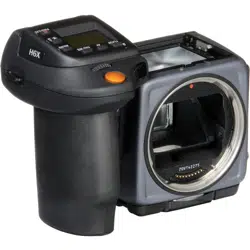Loading ...
Loading ...
Loading ...

29
www.hasselblad.comH6X
NOTE
This section is only about the workflow with compatible Hasselblad digital backs. (CFH, ixpress
CF and H5D sensor unit)
FORMATTING CARDS
New cards sometimes have no formatting, or you might want to convert a card that is currently
using a format that the sensor unit cannot read. In either case, you should reformat a CF card in
the sensor unit for H6X use.
FORMAT BUTTON – for use with H5D sensor units only
Press the Format button on the camera grip. It is purposely recessed to avoid unintentional
use, so use a ball-point pen or similar. A prompt is displayed on the sensor unit for confirmation.
HASSELBLAD CAPTURE FILES, PHOCUS & ADOBE/APPLE SOFTWARE WORKFLOWS
Hasselblad RAW files are initially stored in the 3FR format which is a proprietary Hasselblad format for the temporary storage
of captures. A 3FR file contains the complete digitized raw image exactly as it was captured by the camera. 3FR information
requires further computing power (typically by way of Phocus) to obtain complete development. If developed in Phocus,
3FR files become Hasselblad 3F files – denoted by each file now bearing the suffix “.fff”. If developed by other RAW proces-
sors, the 3FR files are not converted to 3F but can be exported directly to TIFF, PSD etc according to requirements.
However, when working tethered – which necessitates using Phocus – 3FR files are automatically processed and stored in
the background on a computer appearing as 3F files on the hard disk ready for selective adjustment and export. 3FR files
stored on a CF card can be processed to completion using:
• Hasselblad Phocus
• Adobe Camera Raw / Lightroom
• Apple Aperture
To sum up, capture files can be stored as 3FR files (from a CF card) for later processing in Phocus or other software, or they
can be stored as 3F files (as a result of tethered shooting or 3FR files processed and converted in Phocus). In all cases if you
keep the original 3FR/3F files, you will also retain the possibility of reprocessing them in the future in later versions of Phocus
or other software to take advantage of eventual improvements and developments.
Note that using Phocus is the most comprehensive method. The Phocus and Adobe methods can produce almost identical
results (in most cases, but not all) regarding RAW conversion so it is a matter of personal choice regarding which method
would best suit your preferred ways of working. Alternatively you can use Apple Aperture though you should take note that
the benefits of DAC and HNCS etc, will be lost in this case.
Mixed formats
Phocus can also process most other capture formats, generic and proprietary. This means you can include other formats in
your normal Phocus workflow if you choose. Or if you prefer, you can include Hasselblad files in Adobe / Apple workflows
as stated above.
TIFF
JPEG
PSD
DNG
etc.
.nef
.dng
.cr2
.tiff
.mos
.jpeg
etc.
3FR
.fff
.jpeg
With Hasselblad
digital back
Loading ...
Loading ...
Loading ...
